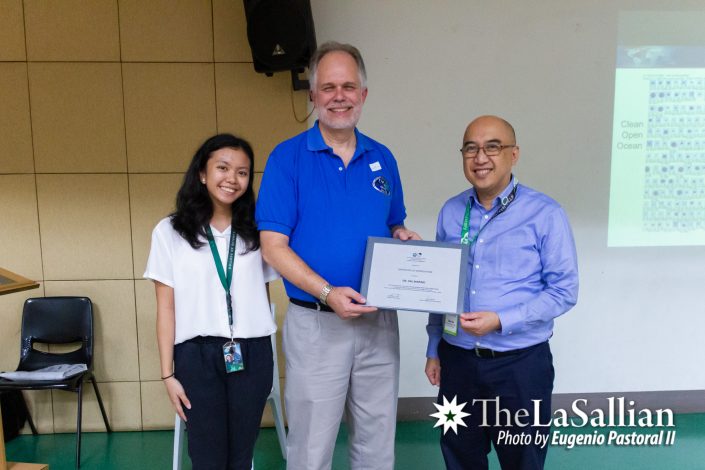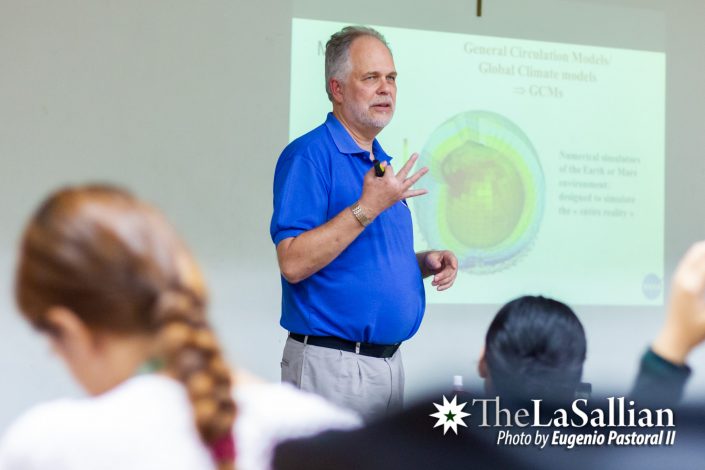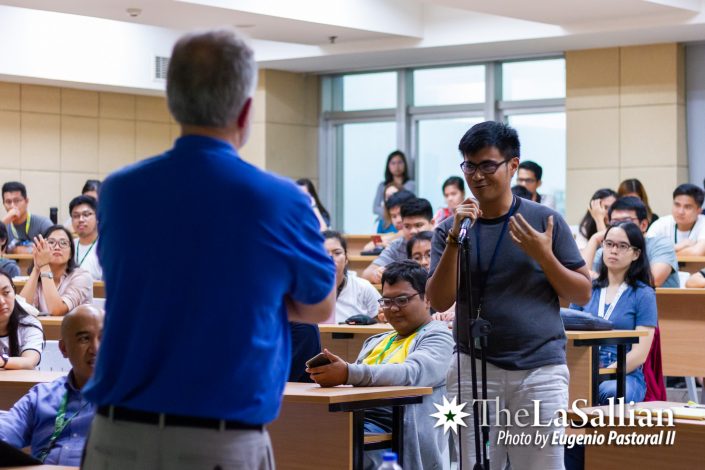Held by the DLSU Science College Government last October 2 at room 703 of the Br. Andrew Gonzalez Hall, WARMING WARNING: NASA’s Take on Climate Change informed the audience about the alarming rate at which the Earth is deteriorating due to global warming and climate change and the measures that the National Aeronautics and Space Administration (NASA) has initiated to combat these.
The event’s key speaker, Dr. Hal Maring, is the Radiation Sciences Program Manager at NASA and one of the leading scientists in the Earth Science Division—one of the organization’s primary branches.

Greenhouse gases and global warming
Maring first introduced the Global Land-Ocean Temperature Index, a graph plotting the temperature anomaly for each year since 1880 to present. Temperature anomalies are defined as measurements that go above or below the long-term average value, often designated as the zero line. For the year 2018, the recorded anomaly was +0.82 degrees Celsius above the norm. Maring explained, “For climate, having a change of even just a degree is like a fever. A change in one degree could have a massive impact on the environment and on living things.”
After showing proof of global warming—which is the gradual surge in temperature of the Earth’s atmosphere—Maring discussed the global energy flows or how energy from the sun interacts with the Earth. “Normally, as sunlight enters the atmosphere, it is partially reflected due to clouds, ice sheets, and other reflective surfaces on our planet. The sunlight that does pass through ends up warming the darker surfaces such as the ground, and is ultimately released back into space,” he explained.
Maring then revealed how greenhouse gases affect the normal energy flow, “Greenhouse gases like carbon dioxide and methane allow sunlight to pass through on its way down. But as it comes back up, it is usually in the form of infrared radiation. As infrared rays could affect carbon dioxide molecules, they get stuck [in the atmosphere], trapping heat.”
The NASA scientist then related this explanation with the rise in global carbon dioxide concentration over time. Aggravated by human activity, this rise in concentration may result in further warming of the planet.
Earth’s guardian angel
NASA continuously measures the composition of air—dating back to the pre-industrial revolution era—in different locations through various methods.
The first is through the Mauna Loa Observatory in Hawaii. Situated at the side of a mountain, the observatory is at a prime location to measure air flow passing through the face of the mountain. As the air cools at night, the observatory takes the opportunity to measure air quality as cool air sinks which gives the observatory an easier time.
NASA also makes use of ice cores, which are usually retrieved by drilling into an ice sheet or glacier, to analyze the characteristics of prehistoric ice and compare it with its present counterpart—with younger snow found on top of older layers since ice forms via the buildup of these snow layers. Maring revealed that “hitting the ice core with a hammer [releases] the trapped air” which NASA then measures in terms of air quality.

Maring explained how the data that was accumulated from these experiments showed a pattern observed across hundreds of thousands of years, signifying periods in earth’s history wherein global warming and global cooling would occur. He explained that by following the pattern extracted from the ice cores, at present, the world should be experiencing a period of global cooling. The data taken from various institutions and organizations worldwide, including NASA’s own findings, however, suggested otherwise.
“We should be expecting global cooling but we don’t see that. We haven’t seen carbon dioxide levels [this] high in over half a million years. We have pushed our Earth’s system outside the bounds of what we know based on [patterns] from the last 500,000 years,” he revealed.
In lesser detail, Maring mentioned NASA’s other methods in measuring air quality including the Airborne Science Program, which makes use of high altitude aircraft that are able to take measurements applicable for various scientific disciplines, especially in Earth science; a system of satellites that characterize and observe every meter of the Earth’s surface; and simulation and modelling of the past, present, and future state of the planet.
“In Earth science, we don’t have a control [group],” Maring elaborated that humanity does not have the means to run experiments on the planet, like quantitatively comparing an earth that burns fossil fuels and another one that does not. He further explained that models enable scientists to simulate instances wherein carbon dioxide levels are high or low and gather the relevant data needed to understand its effects on the world. “We’re constantly trying to improve our models…While our simulations are not 100 percent accurate, we are on our way there,” Maring emphasized that although modeling does not yield entirely accurate results, it is a necessary method to use in conjunction with other techniques to paint a more comprehensive picture on the climate situation.

On the adverse effects of aerosols
Zeroing in on the purpose of the Cloud, Aerosol, and Monsoon Processes-Philippines Experiment Program, Maring explained that the initiative is NASA’s response to the lack of research that has been conducted in the region, specifically in the domains of tropical meteorology—a discipline that involves the study of various processes associated with the climate and the weather—and aerosol science, which deals with atmospheric aerosols, more specifically air pollutants. The NASA scientist furthered the significance of understanding the direct and inadvertent effects that aerosols have on the atmosphere and in turn, on the climate, via their interaction with clouds.
Maring also cited numerous difficulties that the team encountered that were attributed to the region’s extensive cloud cover and the presence of multi-layer clouds, which has significantly impaired remote sensor performance.
“Our satellites have a really hard time—it’s great if we could measure high clouds but [they] obscure almost everything underneath,” he further disclosed. He briefly noted that high clouds—as the name implies—are aerosols that belong in the upper regions of the atmosphere best distinguished by their ability to trap heat. Low clouds, on the other hand, are characterized as aerosols that reflect more sunlight back into space.
“When you fly in an airliner, every once in a while, you’ll notice that the pilot will divert away from [bad] weather—[our flights] divert into it,” he shared, stating that it was necessary in order to acquire the cloud droplets and other parameters they needed for their research.
Diving into the effect of aerosols, Maring likened aerosols with lower and higher concentrations of particles with that of rain and fog, respectively. On one hand, visibility is slightly impaired when driving in rainy weather due to the high amount of rain droplets. On the other hand, when compared to driving through a thick fog, the level of visibility is notably reduced due to the higher amount of tiny water droplets suspended in the air, which severely impedes the distance that light is able to reach.
Building upon this analogy, he explained that as aerosols interact with clouds, the particles collectively absorb sunlight and create a warm layer in the atmosphere, leading to a temperature inversion—a phenomenon wherein the temperature proportionally increases with the altitude.
Maring concluded his talk by highlighting the focal point of their research—collecting and analyzing cloud droplets found in clean air over the ocean and ones found above polluted areas in Luzon. Afterwards, the gathered data sets were measured and quantified to examine the dominant particles that comprise each droplet. This would enable the scientists to construct a centralized data archive as the first step toward attaining a more knowledgeable grasp on the effect of aerosols on the monsoon patterns of the region.
“I don’t want you to think that only NASA can do this. [We] are completely dependent on our colleagues and other space agencies around the world; we work with all of them,” he shared, highlighting the importance of worldwide collaboration among countries to understand and combat climate change.
